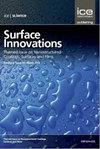用于光电子应用的聚合物纳米复合薄膜的表征及其线性/非线性光学性能
IF 3.5
4区 材料科学
Q3 CHEMISTRY, PHYSICAL
引用次数: 6
摘要
采用铸造溶液法制备了聚苯胺(PANI)和硫化铅(PbSNPs)聚合物纳米复合膜,并将其应用于光能领域。透射显微镜(TEM)、x射线衍射(XRD)和红外光谱(FT-IR)方法表明,PbSNPs被成功地引入到PANI基体中。扫描电镜(SEM)图像显示,PbS在聚苯胺链上均匀加载和分布。利用紫外-可见吸光度,对聚苯胺/PbSNPs的吸收边(Ed)、带隙(Eg)、碳簇数(N)和乌尔巴赫能(Eu)等光学参数进行了评价。研究了PbSNPs对聚苯胺聚合物线性光学特性(LO)以及非线性光学特性(NLO)的影响,包括折射率、非线性磁化率和介电参数。将PANI/PbSNPs膜与纯PANI膜进行比较,发现PANI/PbSNPs样品的带隙明显减小。然而,PbSNPs的加入增加了预测的光电导率和碳簇数。在聚苯胺聚合物中添加pbsnp改善了其光学特性,从而形成了一种可用于能源应用和光电子器件的合成复合材料。本文章由计算机程序翻译,如有差异,请以英文原文为准。
Characterization and linear/nonlinear optical properties of polymer nanocomposite films for optoelectronics applications
Polymer nanocomposite films combining of polyaniline (PANI) and lead sulfide (PbSNPs) were effectively synthesized using a casting solution approach for used in optical energy applications. Transmission microscope (TEM), X-ray diffraction (XRD), and infra-red spectroscopy (FT-IR) methods demonstrate that PbSNPs is successfully introduced into the PANI matrix. Scanning electron microscope (SEM) images reveal that the PbS is homogenously loaded and distributed in PANI chain. Using UV-Vis optical absorbance, the optical parameters of PANI/PbSNPs were evaluated, including absorption edge (Ed), band gap (Eg), carbon cluster number (N) and Urbach energies (Eu). PbSNPs has been investigated for their impact on PANI polymer linear optical (LO) as well as nonlinear optical (NLO) characteristics including refractive index, nonlinear susceptibility, and dielectric parameter’s. When comparing the PANI/PbSNPs film to the pure PANI film, the band gap of the PANI/PbSNPs samples was found to be significantly reduced. However, the addition of PbSNPs increased the predicted amount of optical conductivity and carbon cluster number. The addition of PbSNPs to the PANI polymer improved its optical characteristics, resulting in a synthetic composite that can be used in energy applications as well as optoelectronics devices.
求助全文
通过发布文献求助,成功后即可免费获取论文全文。
去求助
来源期刊

Surface Innovations
CHEMISTRY, PHYSICALMATERIALS SCIENCE, COAT-MATERIALS SCIENCE, COATINGS & FILMS
CiteScore
5.80
自引率
22.90%
发文量
66
期刊介绍:
The material innovations on surfaces, combined with understanding and manipulation of physics and chemistry of functional surfaces and coatings, have exploded in the past decade at an incredibly rapid pace.
Superhydrophobicity, superhydrophlicity, self-cleaning, self-healing, anti-fouling, anti-bacterial, etc., have become important fundamental topics of surface science research community driven by curiosity of physics, chemistry, and biology of interaction phenomenon at surfaces and their enormous potential in practical applications. Materials having controlled-functionality surfaces and coatings are important to the manufacturing of new products for environmental control, liquid manipulation, nanotechnological advances, biomedical engineering, pharmacy, biotechnology, and many others, and are part of the most promising technological innovations of the twenty-first century.
 求助内容:
求助内容: 应助结果提醒方式:
应助结果提醒方式:


